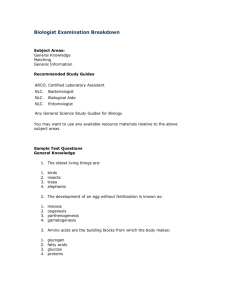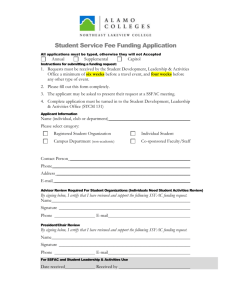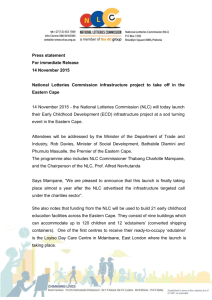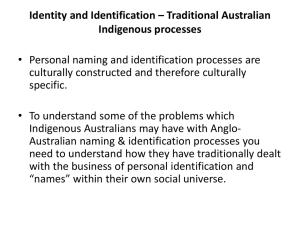N L C R
advertisement
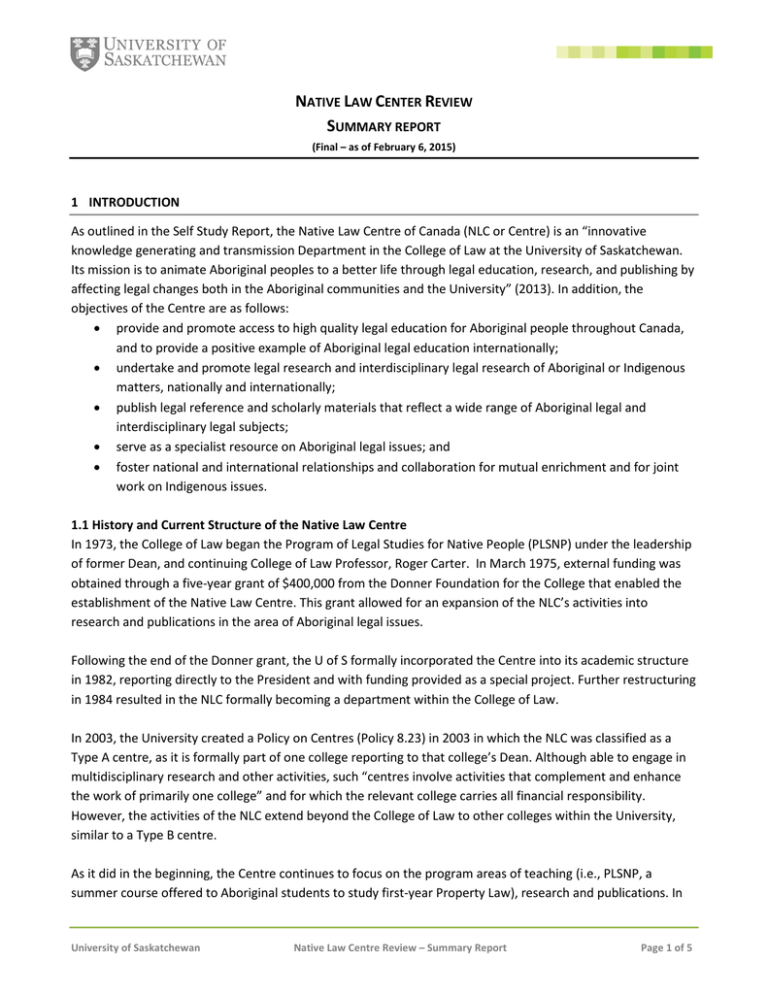
NATIVE LAW CENTER REVIEW SUMMARY REPORT (Final – as of February 6, 2015) 1 INTRODUCTION As outlined in the Self Study Report, the Native Law Centre of Canada (NLC or Centre) is an “innovative knowledge generating and transmission Department in the College of Law at the University of Saskatchewan. Its mission is to animate Aboriginal peoples to a better life through legal education, research, and publishing by affecting legal changes both in the Aboriginal communities and the University” (2013). In addition, the objectives of the Centre are as follows: • provide and promote access to high quality legal education for Aboriginal people throughout Canada, and to provide a positive example of Aboriginal legal education internationally; • undertake and promote legal research and interdisciplinary legal research of Aboriginal or Indigenous matters, nationally and internationally; • publish legal reference and scholarly materials that reflect a wide range of Aboriginal legal and interdisciplinary legal subjects; • serve as a specialist resource on Aboriginal legal issues; and • foster national and international relationships and collaboration for mutual enrichment and for joint work on Indigenous issues. 1.1 History and Current Structure of the Native Law Centre In 1973, the College of Law began the Program of Legal Studies for Native People (PLSNP) under the leadership of former Dean, and continuing College of Law Professor, Roger Carter. In March 1975, external funding was obtained through a five-year grant of $400,000 from the Donner Foundation for the College that enabled the establishment of the Native Law Centre. This grant allowed for an expansion of the NLC’s activities into research and publications in the area of Aboriginal legal issues. Following the end of the Donner grant, the U of S formally incorporated the Centre into its academic structure in 1982, reporting directly to the President and with funding provided as a special project. Further restructuring in 1984 resulted in the NLC formally becoming a department within the College of Law. In 2003, the University created a Policy on Centres (Policy 8.23) in 2003 in which the NLC was classified as a Type A centre, as it is formally part of one college reporting to that college’s Dean. Although able to engage in multidisciplinary research and other activities, such “centres involve activities that complement and enhance the work of primarily one college” and for which the relevant college carries all financial responsibility. However, the activities of the NLC extend beyond the College of Law to other colleges within the University, similar to a Type B centre. As it did in the beginning, the Centre continues to focus on the program areas of teaching (i.e., PLSNP, a summer course offered to Aboriginal students to study first-year Property Law), research and publications. In University of Saskatchewan Native Law Centre Review – Summary Report Page 1 of 5 particular, these three areas are overseen by a research director, director of PLSNP, the legal editor and publication manager, and other key staff involved in the administration of the Centre, PLSNP, publications and communications. 1.2 Purpose of the Summary Report The external review of the Native Law Centre was commissioned by Dean Sanjeev Anand of the College of Law in 2013. As outlined in the Terms of Reference, the main purpose of the review was to “focus, clarify and define for the future the meaning of the NLC as a department of the College of Law”. More specifically, the external review was to address the following four components: • the present status and future aspirations of the NLC’s research and publishing capacity, taking into account that the Centre is addressed to external partnerships with Aboriginal peoples to frame and animate knowledge creation, dissemination, and impact; • the future academic or teaching role of the NLC for various students in the university, especially for law students; • the relationship of the Program of Legal Studies for Native Peoples (PLSNP) to the College of Law; and • the various components of the NLC that can benefit the rest of the university’s Aboriginal engagement priorities as described in the University’s plans and foundational documents. Presented in this summary report is an overview of the external review that was conducted and a synopsis of the key recommendations which emerged based on an assessment of relevant documents provided to the external reviewers and a site visit of the Native Law Centre. 2 OVERVIEW OF CURRENT REVIEW 2.1 External Reviewers The following two individuals were appointed to the external review committee: • Dean Bradford Morse (Dean, Faculty of Law, University of Waikato, New Zealand and Professor Emeritus of University of Ottawa) • D. Heather Raven, QC (Associate Dean, Academic and Student Relations, Faculty of Law, University of Victoria) 2.2 Information Provided to Reviewers Prior to the site visit, the reviewers were provided with numerous documents to assist in their review of the Centre and to enable them to respond to the objectives outlined in the Terms of Reference. In particular, the following documents were provided: • 1991 External Review Report • 2013 self-study report produced by the Centre’s leadership • routine schedule of events for the PLSNP annually • documents describing the PLSNP and its delivery University of Saskatchewan Native Law Centre Review – Summary Report Page 2 of 5 • • • financial information concerning the NLC provided to it via operating grants from the University as well as provincial law foundations, PLSNP grants; publication revenue, gifts and through research grants from the 1991-92 to the 2012-13 fiscal years expenditure overview data from 2008-09 to 2012-13 university documents on key internal terminology, mission statement and strategic plans. In addition, the reviewers supplemented this collection of documents with their respective personal knowledge of the PLSNP’s and the Centre’s development over the decades as well as by reviewing its many publications and websites of the U of S, College of Law and the NLC. 2.3 Site Visit Following a review of the documents provided to them, the reviewers conducted a site visit over a two day period, from November 21 to 22, 2013. During this time, the reviewers met with a total of 23 key individuals, including the following: • seven individuals connected to the Native Law Centre • three senior U of S administrators • Dean of Law • two associate deans • two College of Law administrative staff • eight professors in the College of Law In addition to the individuals listed above, the reviewers also had the opportunity to meet with a number of Indigenous law students during an informal luncheon hosted by the NLC. 2.4 Key Area of Concern It is clear that there has been long-standing interpersonal conflict present between key members of the Native Law Centre. Based on the various interviews that were carried out and the reviewers’ personal knowledge of the Centre, it is their conclusion that, due to this conflict, the Centre is not operating effectively as a unit with a shared vision of how it should operate now and in the future. Furthermore, it is believed that this interpersonal conflict has impacted numerous others, both within and outside of the University of Saskatchewan, and that it has affected the Centre’s reputation and research activity. This conflict must be resolved in order to strengthen the work of the NLC. However, if this is not possible to achieve, it is believed that the recommendations listed below will effectively address the issues which have negatively impacted the Native Law Centre. 3 KEY RECOMMENDATIONS Presented below are the key recommendations provided by the external reviewers. It is believed that by enacting the recommendations, the current functions of the NLC will be strengthened and will help the University of Saskatchewan to retain its place as a national leader in Indigenous education and research and increase the NLC’s ability to engage in national research projects of significance moving forward. University of Saskatchewan Native Law Centre Review – Summary Report Page 3 of 5 The external review led to the overarching recommendation to restructure the three main functions of the NLC and highlighted the importance of effective collaboration among the College and NLC leaders to implement the proposed restructuring. Specific recommendations were made pertaining to the research component of the NLC, publishing and the PLSNP. 3.1 Research Centre a. The research component of the NLC should be re-established as a new research centre. A broadly-based internal committee of the University that includes the Dean of Law and several other members of the College, should determine the best classification as a research centre (as Type A, B or C) within the University system, its future administrative structure, and how academic and administrative appointments are to be made to the Research Centre in the future. b. It should be determined if the research centre’s focus and its selection of researchers should be interdisciplinary (e.g., undertake significant research in other areas of Indigenous interest, such as teaching, governance, economic development, health, education, etc. in addition to law) or remain primarily legally focussed. The outcome of this evaluation could lead to the new centre being reclassified under the University’s Policy on Centres although it is suggested that the College of Law should retain its role as the centre’s primary institutional home. c. It is recommended that a scholar in residence or a newly created research chair in Indigenous Rights be established that may include supervision of Masters and PhD students, a position which could be held by the current NLC research director. In particular, the scholarship of the current research director has been highly influential and in order to provide him with the capacity to concentrate on his significant agenda of research and outreach activities, it is recommended that this new position be free of any managerial responsibilities. 3.2 Publishing a. The publishing functions of the existing NLC should become part of the reconstituted research centre. b. The publication activities of the Centre should be carefully reviewed to determine which publications to retain, the types of publications to produce, and how its publications are to be marketed in an increasingly competitive Indigenous-content publishing world. In addition, moving to a primarily digital format should be considered. 3.3 Program of Legal Studies for Native People a. It is recommended that the PLSNP should become fully integrated into the operations of the College of Law. In particular, the PLNSP director’s expertise and experience in academic support should be utilized to establish and provide a comprehensive academic support program available to all law students (Indigenous and non-Indigenous) in need of academic support. Providing a comprehensive academic support program would ensure that Indigenous students who attend the PLSNP and who register in the College’s JD degree program have the benefit of a seamless transition for their academic support from the PLSNP into and throughout their JD program. University of Saskatchewan Native Law Centre Review – Summary Report Page 4 of 5 b. The College should work with the PLSNP director to establish and provide a cultural support program available primarily to Indigenous students, staff and faculty but open and inviting to non-Indigenous students, faculty and staff who want to learn more about Indigenous cultures. c. The appropriate classification of the PLSNP director should be determined (i.e., as a member of faculty or staff), in consultation with the College and the University. 3.4 Other Recommendations a. It is recommended that the College of Law should formally create the new post of an Associate Dean of Indigenous Affairs as part of its executive team. This person could carry managerial responsibility for a new Indigenous student academic support program, for ensuring the provision of effective financial and human resourcing for the PLSNP, for the development of innovative curriculum on Indigenous issues, representing the College in relation to other relevant Indigenous programs within the University, and being the line manager for the director of the new research centre. b. As the key staff of the NLC are all nearing or past the traditional retirement age, it is essential that both a transition plan and succession planning be developed immediately that encompasses all three of the main streams of the Centre’s activity. This planning and the future recruitment of new staff could be included in the portfolio of the Associate Dean of Indigenous Affairs. 4 CONCLUDING REMARKS It is evident that the University of Saskatchewan naturally wants to retain its place as a national leader in Indigenous education and research, as does the College of Law in legal education and research. As such, the reviewers are optimistic that both the University and the College will find ways to adequately fund a revitalized Indigenous research and publishing centre as well as to provide support for Indigenous students who take up the challenge of a JD program. University of Saskatchewan Native Law Centre Review – Summary Report Page 5 of 5
